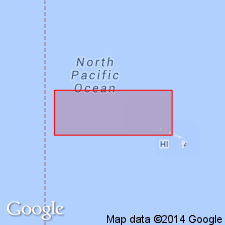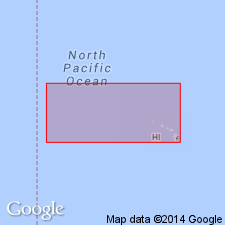
- Usage in publication:
-
- Manana tuff*
- Modifications:
-
- Named
- Dominant lithology:
-
- Tuff
- AAPG geologic province:
-
- Oahu
Summary:
Named for occurrence at Manana Island [Koko Head 7.5' quad] 1.5 mi northwest of Makapuu Head, Island of Oahu. Included in upper part of Honolulu volcanic series. Consists of palagonitized gray to brown lithic tuff. Highest point of Manana Island is 361 ft above sea level. Base of tuff not exposed. On adjacent mainland unconformity overlies Koolau basalt. Manana tuff deposited on beach cobbles of Waimanalo stand of sea. Hence assigned latest Pleistocene or Recent age.
Source: GNU records (USGS DDS-6; Menlo GNULEX).

- Usage in publication:
-
- Manana tuff*
- Modifications:
-
- Overview
- AAPG geologic province:
-
- Oahu
Summary:
Forms Manana (Rabbit) Island, nearly circular island about 0.4 mi in diam, 1.5 mi northwest of Makapuu Head. No fossils. Believed to have formed after Waimanalo stand of sea. Assigned latest Pleistocene or Recent age.
Source: GNU records (USGS DDS-6; Menlo GNULEX).

- Usage in publication:
-
- Manana Tuff†
- Modifications:
-
- Abandoned
- AAPG geologic province:
-
- Oahu
Summary:
Manana Tuff (Stearns, IN Stearns and Vaksvik, 1935) abandoned as formally named unit and called Manana tuff cone, informal unit of Honolulu Volcanics.
Source: GNU records (USGS DDS-6; Menlo GNULEX).
For more information, please contact Nancy Stamm, Geologic Names Committee Secretary.
Asterisk (*) indicates published by U.S. Geological Survey authors.
"No current usage" (†) implies that a name has been abandoned or has fallen into disuse. Former usage and, if known, replacement name given in parentheses ( ).
Slash (/) indicates name conflicts with nomenclatural guidelines (CSN, 1933; ACSN, 1961, 1970; NACSN, 1983, 2005, 2021). May be explained within brackets ([ ]).

